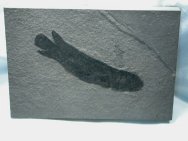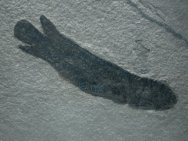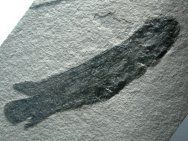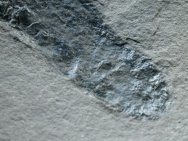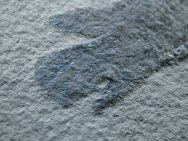Dipterus
valenciennesi
Infraphylum
Gnathostomata, Superclass Osteichthyes, Class Sarcopterygii, Subclass
Dipnoi, Family Dipteridae
Geological
Time: Middle Devonian (385 Million Years Old)
Size: 125
mm
Fossil Site:
Achanarras Slate Quarry, Caithness, Scotland
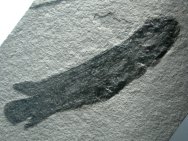 Description:
This is a fine fossil specimen of the first lungfish described in
1828. It is one of the oldest to possess cranial ribs, and is thus
believed to have been capable of gulping air, allowing it to extract
oxygen directly from the atmosphere. The lungfish arose during the
early Devonian, reaching a peak in diversity by the Late Devonian.
While all early Dipnooans were marine, all known from the Carboniferous
on have been freshwater Description:
This is a fine fossil specimen of the first lungfish described in
1828. It is one of the oldest to possess cranial ribs, and is thus
believed to have been capable of gulping air, allowing it to extract
oxygen directly from the atmosphere. The lungfish arose during the
early Devonian, reaching a peak in diversity by the Late Devonian.
While all early Dipnooans were marine, all known from the Carboniferous
on have been freshwater denizens.
A few survive today in Africa, South America, and Australia. The
shine to the specimen is the result of cosmine, a layer of shiny
bony tissue that consists of an external enameloid layer over a
dentine
layer. Cosmine is thought to have comprised apart of the skin’s
complex vascular system. This cosmine layer was lost in most Dipnoan
by the Late Devonian in favor of thinner scales. Interestingly,
the
deposits of Caithness also hold the remains of Palaeospondlyus,
a much smaller fish though by some to be a larval form of Dipterus because
of similar cranial structures. denizens.
A few survive today in Africa, South America, and Australia. The
shine to the specimen is the result of cosmine, a layer of shiny
bony tissue that consists of an external enameloid layer over a
dentine
layer. Cosmine is thought to have comprised apart of the skin’s
complex vascular system. This cosmine layer was lost in most Dipnoan
by the Late Devonian in favor of thinner scales. Interestingly,
the
deposits of Caithness also hold the remains of Palaeospondlyus,
a much smaller fish though by some to be a larval form of Dipterus because
of similar cranial structures.
Also
see: Paleozoic Fish Fossils |
|


